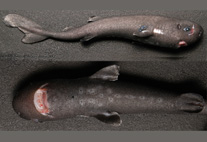Abstract
The description of the pocket shark genus Mollisquama (M. parini Dolganov, 1984) is based on a single known specimen collected from the Nazca Ridge of the southeast Pacific Ocean. A second Mollisquama specimen has been captured in the central Gulf of Mexico establishing a considerable range extension and a parturition locality because the specimen has a healed vitelline scar. Both the holotype of M. parini and the Gulf of Mexico specimen possess the remarkable pocket gland with its large slit-like external opening located just above the pectoral fin. Features found on the Gulf of Mexico specimen that were not noted in the description of M. parini include a series of ventral abdominal photophore agglomerations and a modified dermal denticle surrounded by a radiating arrangement of denticles just posterior to the mouth. Based on a morphometric and meristic comparison of the Gulf of Mexico specimen with information in the description of M. parini, the Gulf of Mexico specimen is identified as Mollisquama sp. due to differences in tooth morphology and vertebral counts. Phylogenetic analysis of NADH2 gene sequences places Mollisquama sister to Dalatias plus Isistius within the family Dalatiidae.

